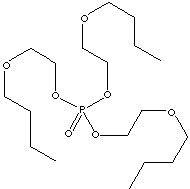PRODUCT IDENTIFICATION

TOXICITY
CLASSIFICATION
Plasticizer
PHYSICAL AND CHEMICAL PROPERTIES
REFRACTIVE INDEX
EXTERNAL LINKS & GENERAL DESCRIPTION
USA.gov - Tris(2-butoxyethyl) phosphate
Wikipedia Linking - Organophosphate
Google Scholar Search - Tris(2-butoxyethyl) phosphate
U.S. National Library of Medicine - Tris(2-butoxyethyl) phosphate
PubChem Compound Summary - Tris(2-butoxyethyl) phosphate
KEGG (Kyoto Encyclopedia of Genes and Genomes) - Tris(2-butoxyethyl) phosphate
ChEBI (http://www.ebi.ac.uk/chebi/) - Tris(2-butoxyethyl) phosphate
NCBI (http://www.ncbi.nlm.nih.gov/) - Tris(2-butoxyethyl) phosphate
Material Safety Data Sheet - Tris(2-butoxyethyl) phosphate
Human Metabolome Database - Tris(2-butoxyethyl) phosphate
Hazardous Substances Data Bank - Tris(2-butoxyethyl) phosphate
EPA - Substance Registry Services - Tris(2-butoxyethyl) phosphate
Local:
Tri(butoxyethyl)phosphate Is used as a primary plasticizer for polymers and elastomers. It is used as a component of floor finishes and fire extinguishing media.
APPEARANCE
96.0% min
COLOR, APHA
80 max
HAZARD OVERVIEW
GHS (Globally Harmonised System) Classification: Acute toxicity (Inhalation, Dermal, Oral). Skin irritation. Eye irritation. Specific target organ toxicity - single exposure. Acute aquatic toxicity. Hazard statements: May be harmful if swallowed. Harmful in contact with skin or if inhaled. Causes skin irritation. Causes serious eye irritation. May cause respiratory irritation. Harmful to aquatic life.
GHS
Warning
PICTOGRAMS

HAZARD STATEMENTS
H303-H312 + H332-H315-H319-H332-H335-H402
P STATEMENTS
P261-P264-P271-P273-P280-P302 + P352-P304 + P340-P305 + P351 + P338-P312-P322-P332 + P313-P337 + P313-P362-P403 + P233-P405-P501
![]()
RISK PHRASES
20/21/22-36/37/38
SAFETY PHRASES
26-37/39